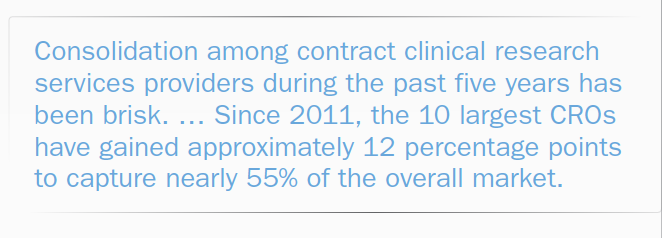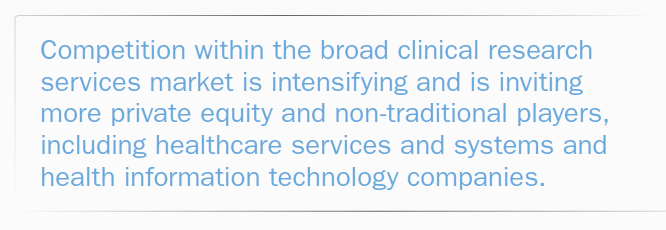Introducing a New Era for Contract Clinical Research Services
Applied Clinical Trials
Traditional and new players are seeing growth and opportunity as the integration of clinical research and healthcare intensifies.
The contract clinical services landscape is undergoing major change that signals a drug development enterprise in profound transition.
Traditional outsourcing is seeing notable increases in market concentration at the same time that specialty service providers are experiencing unprecedented growth. Market leading contract research organizations (CROs) are integrating project management and study conduct services with the hope of gleaning scale efficiencies and economics. In addition, the top four largest CROs have repositioned themselves to meet
Ken Getz

demand for higher levels of patient engagement as well as rich, advanced, and continuous data and analytics supporting learning health and research systems.
Consolidation among contract clinical research services providers during the past five years has been brisk and it has resulted in substantial market share gains among the top 10 largest CROs (e.g., INC Research’s May acquisition of inVentiv Health). In 2011, The Tufts Center for the Study of Drug Development (Tufts CSDD) estimated that the 10 largest CROs captured 43% of the total contract clinical services market. Since 2011, the 10 largest CROs have gained approximately 12 percentage points to capture nearly 55% of the overall market.
Small niche or specialty service providers have also enjoyed strong relative annual growth, approaching 10%. The mid-sized, full-service contract clinical services provider segment is shrinking. Companies in this segment, in the aggregate, have experienced slow relative annual growth (4% between 2011 and 2016) and an unprecedented number of acquisitions, downsizings, and divestitures.
The announced acquisition of Parexel in June by private equity firm Pamplona Capital Management represents a major milestone for the top four largest CROs. Quintiles, Covance, Parexel, and PPD have each now experienced a change of ownership. The new buyers are either strategic partners, well positioned within the broader healthcare and life sciences arena, or private equity investors with considerable capital and broad life sciences portfolios. In all cases, the acquiring companies are not clinical research insiders.
Strategic transactions have been relatively recent and have brought deep pockets, access to systems, infrastructure, and a large volume of medical and health data. In early 2015, Covance was acquired by

LabCorp, one of the nation’s largest healthcare diagnostic companies, for an estimated $6 billion. In May 2016, IMS Health-a market-leading global health information and technology services company-acquired Quintiles. The total value of the transaction was approximately $9 billion.
Private equity has been pursuing deals in the CRO market space for some time. In late 2011, market-leader PPD was acquired for approximately $4 billion by private equity firm Jaguar Holding Company. Since then, Jaguar has been actively acquiring clinical services companies (e.g., patient recruitment provider Acurian) and site management organizations (e.g., Synexus, Radiant Research, and Clinical Research Advantage).
Pamplona’s recent acquisition of Parexel is valued at approximately $5 billion. The valuation represents a 28% premium over Parexel’s May 5, 2017 stock price. Pamplona has a number of healthcare assets, including physician practice management company Formativ Health and healthcare provider evaluation company Spreemo Health.
These buyers anticipate improving operating efficiencies as a result of integrating businesses. More importantly, buyers anticipate growing pre- and post-approval clinical research demand for medical and health data to support development planning; protocol design; investigative site and patient identification and recruitment; the collection of objectively and subjectively reported outcomes; and the assessment of patient and healthcare provider reactions and experiences with medical interventions.
Rationale for profound change
There are numerous factors contributing to changes in the contract clinical services landscape. During the past five years, pharmaceutical and biotechnology companies have continued to downsize. As a result, their dependence on outsourced, variable capacity to handle project execution demands has increased. Tufts CSDD estimates that between 2011 and 2016, nearly 55,000 R&D positions and personnel have been eliminated.
Smaller companies-those spending less than $500 million annually on R&D-also make up a significantly larger proportion of organizations sponsoring molecular entities in the pipeline. Whereas, in 2011, small sponsor companies funded 56% of all projects in the R&D pipeline, in 2016, they funded nearly two-thirds (64%). Many of these small companies are less experienced in managing clinical development projects. Contract clinical services companies offer expertise and act as development functions for these smaller companies.
A very large percentage of mid-sized and major pharmaceutical and biotechnology companies outsource under functional service provider and alliance models. A 2016 CenterWatch study found, for example, that the vast majority (81%) of sponsor companies are using these types of models to obtain preferential pricing and streamlined engagement with simplified governance.
Taken together, Tufts CSDD estimates that in 2016, nearly 50 cents of every R&D dollar was spent on outsourcing. Spending on contract clinical services, specifically, has grown at a significantly faster rate than spending on overall drug development-7.4% annual growth between 2011 and 2016, versus 3.6%. The contract clinical services market now exceeds $30 billion annually, with study monitoring (20% of the total), investigative site management (22%), and data management (12%) making up the largest outsourced services segments.
Despite high dependency on a contract clinical services workforce and changes in the types of outsourcing models used, drug development speed, cost, and success rates have not improved during the past two decades. In some cases, operating conditions have worsened considerably. Tufts CSDD studies have shown that the cost of drug development continues to increase by nearly 9% each year. Development cycle times have gotten longer, with a higher incidence of unplanned delays and changes. And success rates are the worst they have ever been, with only 11% of investigational new drugs (IND) applications filed ultimately receiving FDA approval.
There is tremendous pressure on pharmaceutical and biotechnology companies and their contract research services partners to reverse these perennial operating conditions. Complex protocol designs and consistently poor collaboration execution are major contributors to these conditions and sponsor organizations are evaluating and implementing steps to address them (e.g., protocol review committees; new collaboration governance models and incentives).
Segment strategies; more competition
Market analysts, investors, and industry insiders concede that traditional contract clinical services (e.g., study monitoring, statistical analysis, medical writing, data management) are mature and commoditized, offering limited growth and profitability.
Consolidation among players within the traditional CRO market may deliver scale economies and efficiencies but these gains will likely be short-lived. Niche contract service providers are expected to continue to support demand from a growing pool of smaller sponsor companies and from the larger CROs under subcontract arrangements. Large full-service CROs continue to look for ways to differentiate and, in a bold move, some have vertically integrated into the study conduct and patient recruitment arena (e.g., ICON’s acquisition of site network PMG Research).
Private equity firms and strategic buyers anticipate a far larger and more strategic opportunity. They speculate that the drug development landscape-as it transitions to better target, ever-smaller patient subpopulations and establishes itself within continuous learning health systems-will increasingly turn to differentiated CROs that can offer clinical research services within healthcare systems, massive databases, and advanced informatics. In addition, strategic executives and investors anticipate major opportunities for CROs that have structures, processes, and systems in place that support higher levels of patient engagement through the use of wearable devices and mobile technologies, and through improvements in study volunteer participation convenience and feasibility.
Several private equity-backed companies, have found another entry point to consolidate and combine clinical research services. Arsenal Capital’s WIRB-Copernicus Group (WCG) and Cinven’s Bioclinica are acquiring and rolling-up clinical research services and technology solutions. They have grown dramatically and have built diverse portfolios offering numerous services, including clinical research oversight, study support, and site and patient identification and selection.
During the past five years, WCG acquisitions have included several national and regional institutional review boards (e.g., WIRB and Copernicus), technology company ePharma Solutions, central review firm Medavante, and clinical trial enrollment support firm ThreeWire.

Bioclinica acquisitions have included Blueprint Clinical and its risk-based monitoring technology solution, patient recruitment provider Medici Group, pharmacovigilance services company Synowledge, and investigative site network Compass Research.
Competition within the broad clinical research services market is intensifying and is inviting more private equity and non-traditional players, including healthcare services and systems and health information technology companies.
Contract clinical research services firms are all looking to drive performance improvement, operating efficiencies, and better economics through new synergies among integrated portfolios of assets. In so doing, they not only blur the boundaries between project management and study execution and between drug R&D and healthcare delivery but also they help usher in the integration of clinical research and care.
Ken Getz, MBA, is the Director of Sponsored Research at the Tufts CSDD and Chairman of CISCRP, both based in Boston, MA. email: kenneth.getz@tufts.edu
